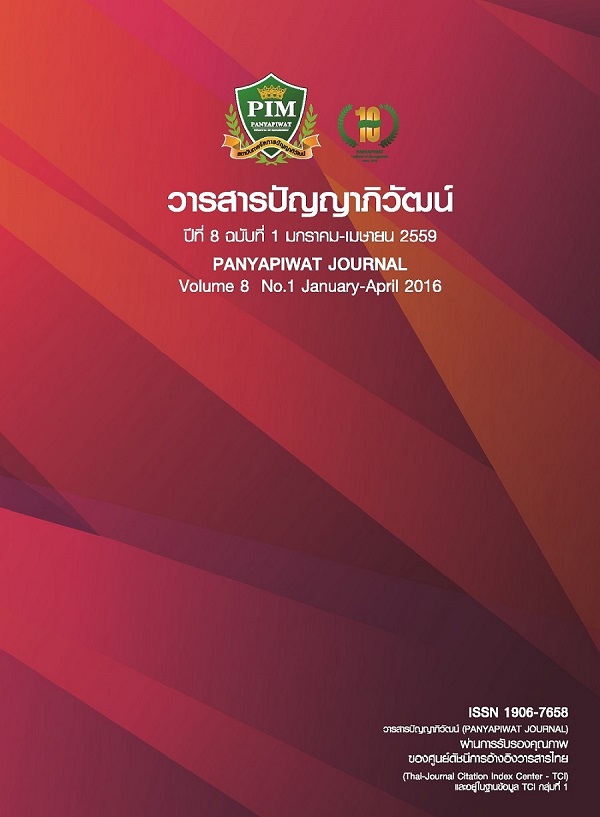การวิเคราะห์องค์ประกอบเชิงยืนยันอันดับที่สองของแบบจำลอง ความสามารถเชิงพลวัตขององค์กร กรณีศึกษาผู้ส่งออกอาหารแปรรูปของไทย
Main Article Content
บทคัดย่อ
งานวิจัยนี้มีวัตถุประสงค์เพื่อพัฒนาตัวบ่งชี้หรือองค์ประกอบของความสามารถเชิงพลวัต กลุ่มตัวอย่างคือ ผู้ส่งออกอาหารแปรรูปของไทย จำนวน 528 ราย ได้จากการสุ่มแบบหลายขั้นตอน เก็บรวบรวมข้อมูลโดยใช้แบบสอบถามแบบสเกลคำตอบ 5 ระดับ นำมาวิเคราะห์ด้วยโปรแกรมสำเร็จรูปตามแนวทางการวิเคราะห์โมเดลสมการโครงสร้าง ผลการวิจัย พบว่า สามารถจัดกลุ่มตัวแปรแฝงและกำหนดเป็นตัวบ่งชี้ของความสามารถเชิงพลวัตได้ 4 องค์ประกอบ คือ ความสามารถในการรับรู้โอกาสทางธุรกิจ การแสวงหาทรัพยากร การแสวงหาความร่วมมือ และการปรับโครงสร้างทรัพยากร จากการตรวจสอบยืนยันว่า แบบจำลองการวัดที่พัฒนาขึ้นมีความสอดคล้องกับข้อมูลเชิงประจักษ์ และมีความเที่ยงตรงในการวัดอยู่ในระดับสูง โดยมีค่า X2 = 347.54 ค่าองศาอิสระ = 145 p = 0.000 ค่า NFI = 0.976 ค่า NNFI = 0.981 ค่า CFI = 0.986 ค่าRMSEA = 0.050 ค่า RMR = 0.035 ค่า SRMR = 0.044 ค่า GFI = 0.940 และค่า AGFI = 0.912
The purpose of this study to develop composite indicators of dynamic capability. A quantitative method of analysis was employed for a total of 528 thai processed food exporters by multistage random sampling, data collected using 5-point likert scales of questionnaire and analyzed the model using a structural equation modeling approach.
The results demonstrated that the composite Indicator of dynamic capability consisted of four latent variables of opportunity search, resource acquisition, seeking business cooperation and organizational structure. The test of the second order CFA model implies that four latent variables were the good fit for measuring dynamic capability construct. The goodness-of-fit indices indicated that the research model was congruent to empirical data : X2 = 347.54 df= 145 p = 0.000 NFI = 0.976 NNFI = 0.981 CFI = 0.986 RMSEA = 0.050 RMR = 0.035 SRMR = 0.044 GFI = 0.940 and AGFI = 0.912
Article Details
“ข้าพเจ้าและผู้เขียนร่วม (ถ้ามี) ขอรับรองว่า บทความที่เสนอมานี้ยังไม่เคยได้รับการตีพิมพ์และไม่ได้อยู่ระหว่างกระบวนการพิจารณาลงตีพิมพ์ในวารสารหรือแหล่งเผยแพร่อื่นใด ข้าพเจ้าและผู้เขียนร่วมยอมรับหลักเกณฑ์การพิจารณาต้นฉบับ ทั้งยินยอมให้กองบรรณาธิการมีสิทธิ์พิจารณาและตรวจแก้ต้นฉบับได้ตามที่เห็นสมควร พร้อมนี้ขอมอบลิขสิทธิ์บทความที่ได้รับการตีพิมพ์ให้แก่สถาบันการจัดการปัญญาภิวัฒน์หากมีการฟ้องร้องเรื่องการละเมิดลิขสิทธิ์เกี่ยวกับภาพ กราฟ ข้อความส่วนใดส่วนหนึ่งและ/หรือข้อคิดเห็นที่ปรากฏในบทความข้าพเจ้าและผู้เขียนร่วมยินยอมรับผิดชอบแต่เพียงฝ่ายเดียว”
เอกสารอ้างอิง
กระทรวงพาณิชย์. (2555). ฐานข้อมูล Thailand Trading Report. สืบค้นเมื่อ 26 ธันวาคม 2555, จาก http://www2.ops3.moc.go.th/
กระทรวงอุตสาหกรรม. (2554). แผนแม่บทการพัฒนาอุตสาหกรรมไทย พ.ศ. 2555-2574. สืบค้นเมื่อ 26 สิงหาคม 2555, จาก http://www.industry.go.th/5/Forms/AllItems.aspx
นงลักษณ์ วิรัชชัย. (2542). โมเดลลิสเรล: สถิติวิเคราะห์สำหรับการวิจัย (พิมพ์ครั้งที่ 3). กรุงเทพฯ: โรงพิมพ์แห่งจุฬาลงกรณ์มหาวิทยาลัย.
Amit, R. & Schoemaker, P. J. (1993). Strategic assets and organisational rent. Strategic Management Journal, 14(January), 33-46.
Augier, M. & Teece, D. J. (2009). Dynamic Capabilities and the Role of Managers. Organization Science, 20(2), 410-421.
Cillo, P., Verona, G. & Vicari, S. (2007). The interlink between resources and Capabilities: towards a theoretical frame for the development of dynamic capabilities. International Journal of Learning and Intellectual Capital, 4(1), 111-131.
Eisenhardt, K. M. & Martin, J. A. (2000). Dynamic Capabilities: What Are They?. Management Journal, 21(10/11), 1105-1121.
Griffith, D. A. & Harvey, M. G. (2001). A Resource Perspective of Global Dynamic Capabilities. Journal of International Business Studies, 32(3), 597-606.
Hair, J. F., Black, W. C., Babin, B. J. & Anderson, R. E. (2010). Multivariate data analysis. (7th ed.). New Jersey: Prentice-Hall.
Helfat, C. E. (1997). Know-how and Asset Complementarity and Dynamic Capability Accumulation: The Case of R&D. Strategic Management Journal, 24(10), 997-1010.
Helfat, C. E., Finkelstein, S., Mitchell, W., Peteraf, M. A., Singh, H., Teece, D. J. & Winter, S. G. (2007). Dynamic Capabilities: Understanding Strategic Change in Organizations. Malden MA: Blackwell Publishers.
Lee, J., Lee, K. & Rho, S. (2002). An Evolutionary Perspective on Strategic Group Emergence: A Genetic Algorithm-Based Model. Strategic Management Journal, 23(8), 727-747.
Leonidou, L. C., Katsikeas, C. S. & Samiee, S. (2002). Marketing strategy determinants of export performance: A meta-analysis. Journal of Business Research, 55(1), 51-67.
Macpherson, A., Jones, O. & Zhang, M. (2004). Evolution or revolution? Dynamic capabilities in a knowledge-dependent firm. R&D Management, 34(2), 161-175.
Prahalad, C. K. & Hamel, G. (1990). The core competence of the corporation. Harvard Business Review, 68(May-June), 79-91.
Priem, R. L. & Butler, J. E. (2001). Is the Resource-Based View a Useful Perspective for Strategic Management Research?. Academy of Management Review, 26(1), 22-40.
Rindova, V. & Taylor, M. S. (2002). Dynamic Capabilities as Macro and Micro Organizational Evolution. Retrieved June 1, 2011, from http://libra.msra.cn/Publication/6944265/dynamic-capabilities-as-macro-and-micro-organizational-evolution
Schermelleh-Engel, K., Moosbrugger, H. & Müller, H. (2003). Evaluating the fit of structural equation models: Test of significance and descriptive goodness-of-fit measures. Methods of Psychological Research – Online, 8(2), 23-74.
Teece, D. J. & Pisano, G. (1994). The Dynamic Capabilities of Firms: An Introduction. Industrial and Corporate Change, 3(E), 537-556.
Teece, D. J., Pisano, G. & Shuen, A. (1997). Dynamic capabilities and strategic management. Strategic Management Journal, 18(7), 509-533.
Teece, D. J. (2007). Explicating dynamic capabilities: the nature and microfoundations of enterprise performance. Strategic Management Journal, 28, 1319-1350.
Wang, C. L. & Ahmed, P. K. (2007). Dynamic Capabilities: A Review and Research Agenda. International Journal of Management Reviews, 9(1), 31-51.
Wernerfelt, B. (1995). The resource-based view of the firm: Ten years after. Strategic Management Journal, 16(March), 171-174.
Winter, S. G. (2003). Understanding Dynamic Capabilities. Strategic Management Journal, 24(10), 991-995.
Zahra, S. & George, G. (2002). Absorptive Capacity: A Review, Reconceptualization and Extension. Academy of Management Review, 27(2), 185-203.
Zahra, S. & Nielsen, A. (2002). Sources of capabilities, integration and technology commercialization. Strategic Management Journal, 23(5), 377-398.
Zollo, M. & Winter, S. G. (2002). Deliberate Learning and the Evolution of Dynamic Capabilities. Organization Science, 13(3), 339-351.
Zucchella, A. & Scabini, P. (2007). International entrepreneurship: theoretical foundations and practices. London: Palgrave Macmillan.
Translated Thai References
Ministry of Commerce. (2012). Database of Thailand Trading Report. Retrieved December 26, 2012, from, http://www2.ops3.moc.go.th/ [in Thai]
Ministry of Industry. (2011). National Industrial Development Master Plan for 2012-2031. Retrieved August 26, 2012, from http://www.industry.go.th/5/Forms/AllItems.aspx [in Thai]
Wiratchai, N. (1999). LISREL: Statistical analysis for research. (3rd ed.). Bangkok: Chulalongkorn University Printing House. [in Thai]


